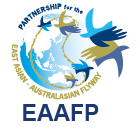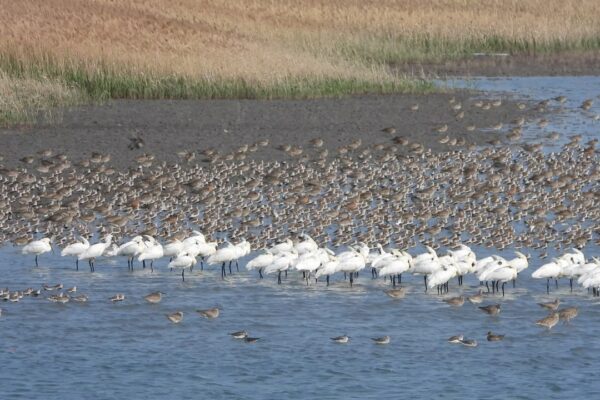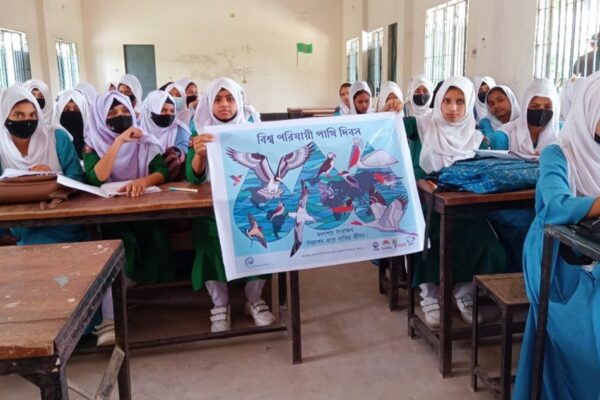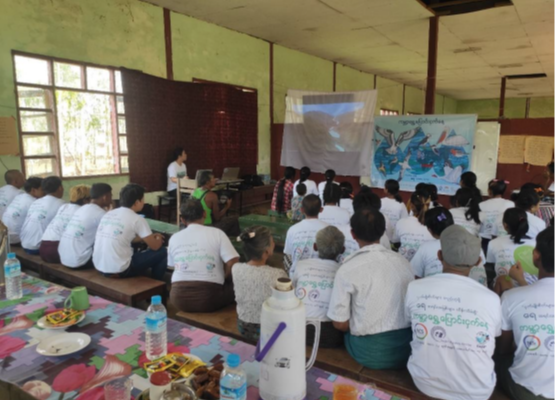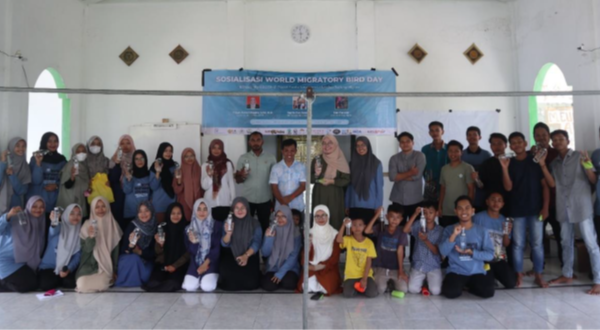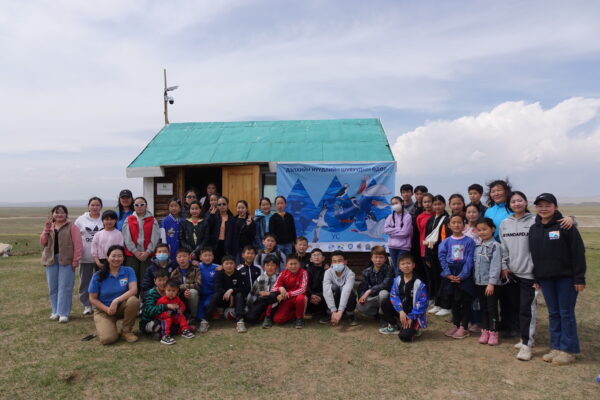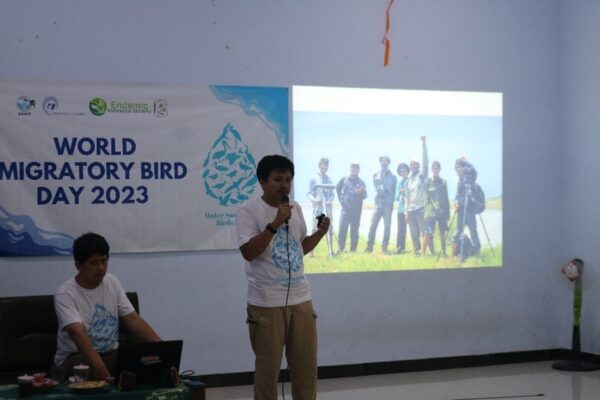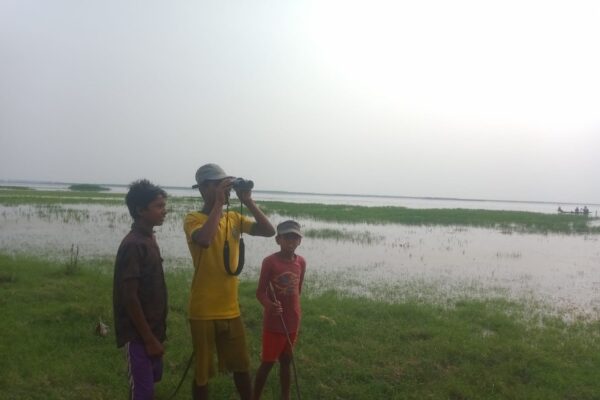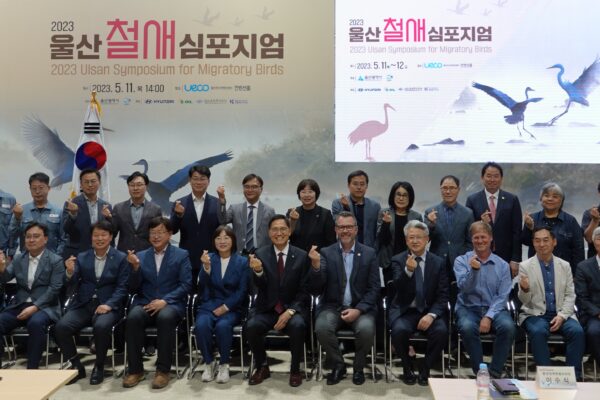-
Republic of Korea: Yeongjong Tidal Flat Bird Monitoring Reveals High Conservation Value
The comprehensive bird monitoring conducted at Yeongjong Tidal Flat in Incheon, Ro Korea, in 2022, led by a team of dedicated citizen scientists and local NGOs (Green Korea Incheon and Waterbird Network Korea) has yielded scientific insights into the ecological significance of this habitat. The survey findings provide substantial evidence supporting the potential listing of Yeongjong Tidal Flat as a World Natural Heritage site proved to be a globally significant habitat for endangered bird species. © Yeongjong Tidal Flat Monitoring Team Over 16 surveys spanning April to November 2022, the team investigated the population dynamics and migratory patterns of seven endangered bird species. The survey locations included Yaedanpo Port, Midan City, Songsan Reservoir, Hongdae Salt Field, and Incheon Bridge. © Yeongjong Tidal Flat Monitoring Team The observations revealed a total count of 14,518 individuals across the seven targeted species. The birds exhibited dynamic site selection, utilizing survey points as strategic feeding and resting sites aligned with tidal patterns. Notably, during high tides, the Songsan Reservoir and dormant Hongdae Salt Field emerged as significant resting sites. © Yeongjong Tidal Flat Monitoring Team Of particular importance is the presence of the Far Eastern Curlew, a migratory bird covering vast distances between Siberia and Southeast Australasia. Yeongjong Tidal Flat was found to host approximately 18% of the estimated global population (35,000 individuals) of this species, according to Wetland International. Far Eastern Curlews (left) and Black-faced Spoonbills (right) © Yeongjong Tidal Flat Monitoring Team Furthermore, Yeongjong Tidal Flat supports approximately 10% of the maximum breeding population of the Black-faced Spoonbill, which over 80% of its global population breeds in Incheon. Eurasian Oystercatcher (left) and its eggs (right) © Yeongjong Tidal Flat Monitoring Team The Eurasian Oystercatchers, predominantly nesting near the First Dredge Dumping Grounds, also exhibited substantial breeding activity, though some nests faced challenges with egg disappearance or damage. The presence of campers utilizing interior spaces of the First Dredge Dumping Grounds during the breeding season poses an additional threat to the successful reproduction of Eurasian Oystercatchers. © Yeongjong Tidal Flat Monitoring Team Situated within the East Asian-Australasian Flyway (EAAF), Yeongjong Tidal Flat serves as a vital resting and feeding ground for internationally protected bird species. Consequently, urgent conservation efforts are necessary to secure its inclusion on the UNESCO World Heritage list during the 48th session of the committee in 2026. The designation of Yeongjong Tidal Flat as a protected wetland area and recognition as a World Natural Heritage site would ensure the preservation of its ecological significance. © Yeongjong Tidal Flat Monitoring Team In addition to birds recorded, the team also found the Milky Fiddler Crab at the site which is a Nationally Endangered Species (Category II). Milky Fiddler Crab © Ju Hyeok Lee/EAAFP Secretariat The recent inauguration ceremony for the second batch of the Yeongjong Tidal Flat Bird Monitoring Team signifies ongoing efforts in monitoring avian populations within this unique ecosystem. A conference focused on Yeongjong Tidal Flat conservation, based on the survey results, is planned for the end of the year, facilitating collaboration among stakeholders. © Yeongjong Tidal Flat Monitoring Team The results of the Yeongjong Tidal Flat bird monitoring project provide scientific evidence of its high conservation value. Listing Yeongjong Tidal Flat as a World Natural Heritage site would ensure appropriate protection and conservation measures for the endangered bird species that rely on this habitat. The dedication of the monitoring team, citizen scientists, and stakeholders involved in preserving Yeongjong Tidal Flat will play a pivotal role in securing a sustainable future for this important ecosystem and its avian inhabitants. Read the report (in Korean) here. Article prepared by Yeongjong Tidal Flat Monitoring Team.
Continue reading -
Engaging Events Raise Awareness on Migratory Birds and Conservation in Kushtia, Bangladesh
In an effort to raise awareness among the urban population of Kushtia town in Bangladesh about migratory birds and their conservation, a vibrant "Migratory Bird Fair" was organized at the No. 6 Primary School Compound on 20th May, 2023. Preceding the fair, a campaign was conducted in five schools to engage students and encourage their participation in the event. The fair and subsequent community awareness program successfully educated and inspired participants, fostering a sense of responsibility toward the protection of migratory species and their habitats. School campaign before the fair ©️ Kichir-Michir Near 640 participants joined the events. The campaign targeted students from The Old Kushtia High School, Kushtia Mission School, Merit Model School, GK High School, and No. 6 Primary School. Students from grades 1 to 8 were informed about migratory birds, the significance of World Migratory Bird Day, and the theme of 2023. They were also invited to submit their artworks on the theme of "Water: Sustaining Bird Life." The fair organizers set up banners in all five schools to invite the community to participate. Judges selecting top best artworks before the fair ©️ Kichir-Michir Over 150 students eagerly submitted their artworks, out of which 25 were selected for exhibition, with the top three receiving special recognition. The fair itself was a visual treat, featuring an attractive photo-frame adorned with important migratory bird species. A spotting scope placed within the frame allowed visitors to observe small bird idols placed at a distance, demonstrating the joy of birdwatching. Additionally, 100 migratory bird photos, bird magazines, and birdcalls added up to the immersive experience. Birds being demonstrated to visitors ©️ Kichir-Michir Bird magazines for reading ©️ Kichir-Michir Migratory Bird Photo-frame with a spotting scope ©️ Kichir-Michir The fair commenced with a rally featuring larger-than-life creations of Spoon-billed Sandpiper, Masked Finfoot, Black-tailed Godwit, Whiskered Tern, and Gray-headed Lapwing, along with a banner. Following the rally, the event was inaugurated by guests, accompanied by a captivating performance of a song on Bangladesh's birds by a talented fourth-grade student. The guests and organizers delivered speeches emphasizing the importance of migratory birds, World Migratory Bird Day, local migratory bird species, and conservation efforts. Rally ©️ Kichir-Michir During the fair, two individuals from an adjacent village who contributed to bird conservation efforts were honored, along with the invited guests. The top 25 participating students were also rewarded, with special prizes for the top three artworks. The fair attracted approximately 558 visitors throughout the day, creating a platform for community engagement and education. Migratory Bird Fair inauguration program ©️ Kichir-Michir Prize being given to a student for artwork ©️ Kichir-Michir In continuation of the initiative, a community awareness program was organized on May 27, 2023, targeting the grass-cutters of Char Bhabanipur, Pabna. The program aimed to educate the community on the importance of protecting grass patches and discouraging harmful activities like hunting. The event included the placement of a signboard, discussions with influential community members, and the distribution of T-shirts and posters. Setting up signboard, and demonstrating and distributing posters ©️ Kichir-Michir Community awareness program ©️ Kichir-Michir Through these events, Kichir-Michir successfully educated and raised awareness among participants about migratory birds and their conservation. By instilling a sense of responsibility, the initiative strives to reduce hunting, habitat destruction, and other detrimental activities. The efforts of Kichir-Michir and the collaboration with local schools and organizations exemplify the power of community involvement in protecting these majestic avian travelers and preserving their habitats. Participants with t-shirts and posters ©️ Kichir-Michir Overall, these events served as a testament to the significance of World Migratory Bird Day and its role in fostering knowledge, appreciation, and action for the conservation of migratory birds in Kushtia, Bangladesh. The project was funded through the 2023 EAAFP WMBD Small Grant Fund. View the report, Click here. Article prepared by Kichir-Michir
Continue reading -
World Migratory Bird Day 2023 Celebrated in Aceh, Indonesia, for students with special needs “Everyone Can Protect Birds”
World Migratory Bird Day (WMBD) 2023 was celebrated in Aceh, Indonesia with great enthusiasm and a series of engaging activities organized by the Pusat Riset Konservasi Gajah dan Biodiversitas Hutan (PKGB) at Syiah Kuala University. The aim of the event was to raise awareness and involve over 8-participants, including teachers, and students with special needs, in the conservation of migratory birds and their habitats. ©️ PKBG-USK The event kicked off with a seminar on 25th May 2023, with the theme "Water: Sustaining Bird Life." The seminar, held in collaboration with the Research Center for Elephant Conservation and Forest Biodiversity (PKGB) and the Pembina Aceh Province State SLB, featured two sessions. In the first session, Mrs. Maria Ulva, an expert in practicing children with special needs, introduced different bird species using hand puppets as visual aids. This method proved effective in engaging students with special needs and helping them understand and appreciate birds. ©️ PKBG-USK Dr. Abdullah, the head of the Research Center for Elephant Conservation and Forest Biodiversity, led the second session. He discussed small activities that individuals can undertake to protect the environment, such as avoiding smoking, littering, and consuming wild birds. The session also included an introduction to various migratory bird species found in Aceh Province through audiovisual presentations. One of the highlights of the celebration was the application of inclusive education methods. This approach aimed to provide equal educational opportunities to all students, including those with special needs, by incorporating migratory bird conservation materials into the curriculum. Teachers played a crucial role in adapting the learning materials and techniques to suit the needs of students with different limitations. The efforts resulted in an inclusive learning environment where all students could actively participate and understand the importance of bird conservation. ©️ PKBG-USK The event also featured a Migratory Bird Festival, during which students and parents received souvenirs and learning aids to support their education. Teachers and committee members who demonstrated exceptional skills in explaining the materials to students were also recognized with souvenirs. As a symbolic gesture, birds were released by the students and teachers to promote the idea of birds thriving in their natural habitats rather than being confined in cages. ©️ PKBG-USK The outcomes of the World Migratory Bird Day 2023 event were significant. Students with special needs gained knowledge about birds, conservation, and environmental preservation. Teachers were educated about the importance of preventing the consumption of wild birds and involving parents in ecosystem conservation efforts. The event fostered a sense of responsibility and appreciation for nature among the younger generation. ©️ PKBG-USK The Pusat Riset Konservasi Gajah dan Biodiversitas Hutan (PKGB) at Syiah Kuala University, along with their partners and sponsors, successfully organized a memorable World Migratory Bird Day celebration. The event showcased the power of inclusive education, creative teaching methods, and community involvement in raising awareness about migratory birds and their habitats. It left a lasting impact on the participants, empowering them to contribute to the conservation of our natural heritage. The project was funded through the 2023 EAAFP WMBD Small Grant Fund. View the report, Click here. Article prepared by Pusat Riset Konservasi Gajah dan Biodiversitas Hutan, Syiah Kuala University
Continue reading -
World Migratory Bird Day 2023: Promoting Conservation Efforts and Local Engagement in Myanmar
The Nature Conservation Society-Myanmar (NCS-Myanmar) successfully organized the World Migratory Bird Day (WMBD) event for 2023 on 18th May. The event took place in Koe Tae Su Village near the Gulf of Mottama (GoM) in Myanmar, with a total of 77 participants, including school students, villagers, and local communities. Supported by the East Asian-Australasian Flyway Partnership (EAAFP), this event aimed to raise awareness about the significance of migratory birds and their habitats, while actively involving the local population in conservation efforts. © Nature Conservation Society-Myanmar The event commenced with an engaging opening ceremony, featuring a speech by the Head of the Local Community, who warmly welcomed the participants to WMBD 2023. The NCS-Myanmar team provided an insightful presentation on the formation of WMBD and its yearly themes, emphasizing the importance of water in sustaining bird life. The audience was captivated by the "Migratory Bird" song in Burmese, created specifically for WMBD 2020, along with other videos highlighting the journey and challenges faced by migratory birds. Following the opening ceremony, the workshop focused on the conservation of migratory birds in the GoM. NCS-Myanmar experts delivered presentations on various topics, including animal migration, the importance of wetlands and water for migratory birds, and the threats they face in the GoM. Participants were educated about the socio-ecological justice required for environmental conservation. They also explored the correlation between their livelihoods and migratory birds through group discussions, covering subjects such as bird hunting, attitudes towards migratory birds, traditional knowledge, local organization activities, and livelihoods and poverty reduction. © Nature Conservation Society-Myanmar One remarkable aspect of the event was the active participation of women, who contributed their valuable perspectives and visions. The attendees already had some knowledge of bird migration in their area from previous events, but this occasion provided them with a deeper understanding of the benefits of establishing conservation zones for birds. They expressed their desire for more conservation zones in the region to mitigate habitat loss and threats to migratory birds. Throughout the event, attendees enjoyed educational presentations, engaging discussions, and inspiring videos on migratory birds. The NCS-Myanmar effectively fostered an atmosphere of learning and enjoyment, ensuring that participants gained a comprehensive understanding of the importance of environmental conservation and habitat preservation for migratory birds. © Nature Conservation Society-Myanmar The World Migratory Bird Day 2023 event in Myanmar, organized by NCS-Myanmar, proved to be a resounding success, as it helped to raise awareness about migratory birds and their habitats among local communities, students, and villagers. By actively involving participants in workshops and discussions, NCS-Myanmar empowered the local population to contribute to the conservation of migratory birds in the GoM. The event highlighted the need for socio-ecological justice and emphasized the crucial role of water in sustaining bird life. It is hoped that such initiatives will continue to be organized, promoting environmental conservation and habitat preservation for migratory birds in their flyways. The project was funded through the 2023 EAAFP WMBD Small Grant Fund. View the report, Click here. Article prepared by Nature Conservation Society-Myanmar
Continue reading -
Aceh Bird Club Celebrates World Migratory Bird Day 2023 with Engaging Activities to Keep Water from Plastic Waste in Indonesia
The Aceh Bird Club, in collaboration with the Biology Education Student Association (HIMABIO) at Syiah Kuala University, Ache, Indonesia, recently organized a remarkable series of events to celebrate World Migratory Bird Day 2023. The week-long event, held from 14th to 21st May 2023, aimed to raise awareness about the importance of protecting the environment, migratory birds, and their habitats. With the active participation of students, university students, environmentalists, communities, lecturers, and several related agencies, the event was a resounding success. © Aceh Bird Club The festivities commenced with three engaging competitions: a short video competition, a photography competition, and an essay-writing competition. Open to participants of all ages, these competitions served as platforms to educate the younger generation about the detrimental impact of microplastics on water and its consequences for both humans and migratory birds. The competitions were conducted online, allowing contestants to submit their entries through an online form provided by the committee. A total of 30 contestants participated, showcasing their talent and commitment to environmental conservation. © Aceh Bird Club The winners of the photography competition captured stunning images that conveyed the theme, "Save Water for the Future of Migratory Birds and Humans." Muhammad Al Fatih from UNS clinched the 1st position with his captivating photograph titled "Milik Bersama" (Shared Ownership). Hudzaifah Fahroni from UNJ secured the 2nd position with his compelling image titled "Pengunjung tetap teluk Jakarta" (Visitors of Jakarta Bay), while Haris Akbar Hidayat from IPB won the 3rd position with his evocative photograph titled "Berbagi Ruang" (Sharing Space). Click [here] to see the winning photos! © Aceh Bird Club In the short video competition, Muslim, Gansar, and M. Akbar, all from Syiah Kuala University, emerged as the top three winners. Their videos conveyed powerful messages about the importance of protecting water for migratory birds and the future of humanity. Click [here] to see the winning short videos! © Aceh Bird Club Furthermore, the essay writing competition challenged students to think critically and propose innovative ideas on the topic "Utilization of Technology for Monitoring Waste and Microplastics." Imam Safir Alwan Nurza from UNJ won the 1st position with his essay titled "Decase U-Bot", followed by I Made Egga Adika Saputra from Denpasar in 2nd place and Presty Wulandari from Gorontalo State University in 3rd place. Click [here] to see the winning essays! © Aceh Bird Club The pinnacle of the event was the campaign held at the Peulanggahan village hall in Banda Aceh on 20th May 2023. The campaign featured two expert presenters, Fitrah Asma Ulhusna and Heri Tarmizi, who enlightened the 50 participants about the types and dangers of microplastics to both residents and migratory birds. The event also included interactive sessions, distribution of educational materials, souvenirs, and prizes to recognize outstanding participants. The event concluded with a cleanup activity along the river in the Lampulo area of Banda Aceh on 21st May. Attended by 70 participants, including students, university students, environmentalists, and the local community, this initiative aimed to create awareness about waste disposal and environmental preservation. The activity received extensive media coverage and inspired individuals to protect the environment and dispose of waste responsibly. © Aceh Bird Club © Aceh Bird Club The Aceh Bird Club's celebration of World Migratory Bird Day 2023 successfully fostered environmental consciousness among participants of all ages. By combining competitions, campaigns, and community engagement, the event highlighted the significance of preserving our ecosystems for the benefit of migratory birds and humanity. © Aceh Bird Club The project was funded through the 2023 EAAFP WMBD Small Grant Fund. View the report, Click here. View the event photos on the Flickr Album [here]. Article prepared by Aceh Bird Club
Continue reading -
Discovering local wetlands: the vital habitat of migratory birds in Mongolia
On May 13th, Saraana Nature Conservation Foundation (SNCF) held an event ‘Discovering local wetlands: the vital habitat of migratory birds’ to celebrate 2023 World Migratory Bird Day (WMBD). As the theme of this year is ‘Water: Sustaining Bird Life’, SNCF held an event that is focused on discovering wetlands and migratory birds. © Saraana Nature Conservation Foundation The event aimed to educate and inspire young minds at Bayandelger Soum in Tuv Province about the importance of wetlands and foster a sense of interest in migratory birds. Thirty-five Students and three teachers from Bayandelger Secondary School were our main participants, the first program of the event was a presentation about migratory birds and WMBD by Sarangerel Ichinkhorloo, the head of SNCF. © Saraana Nature Conservation Foundation After the presentation, the students and teachers headed to the Gun-Galuut Nature Conservation Center (GGNCC) at the Gun-Galuut Locally Protected Area (GGLPA). GGNCC is an information, training, and research center, that aims to monitor local biodiversity, especially birds as an umbrella species, and run conservation and educational activities. Moreover, GGLPA is a birding hotspot located 130km far from the capital city, which comprises wetlands such as lakes, river basins, streams, and oases. Its area serves as an important resting, feeding, and breeding habitat for migratory birds, especially threatened species such as White-naped Crane, Siberian Crane, Dalmatian Pelican, etc. © Saraana Nature Conservation Foundation At the GGNCC, SNCF staff and student volunteers shared their knowledge about the GGLPA, wetlands and biodiversity including migratory birds. At the GGNCC building, information on GGLPA and wetlands was shared, also, bird monitoring and ringing equipment were instructed to the participants. At the yurt (Mongolia Ger), the traditional style of Mongolia house, participants had a chance to learn more about bird species with pictures. During the instruction, students were actively responsive to the content and showed their interest in birds. © Saraana Nature Conservation Foundation For further activities, participants walked all together to one of the wetlands at GGLPA, the Ikh Gun Lake. At the Ikh Gun Lake, the SNCF ran three stations each with different themes: Birdwatching, Invertebrates Survey, and Water Survey. At the Birdwatching Station, participants observed birds by the lakes through binoculars and telescopes. They observed more than 10 migratory bird species such as Demoiselle Crane and Pied Avocet. © Saraana Nature Conservation Foundation At Invertebrates and Water Survey stations, participants drew water from the lake and took a deeper observation with magnifiers and pH test papers. They used scoop nets to find invertebrates from the lake to understand the biodiversity of wetlands. Also, they tested the acidity (pH level) of wetlands and compared it with drinking water, understanding the water filtration function of the wetlands. © Saraana Nature Conservation Foundation During the outdoor activities, the wind was strong, but it couldn’t stop students’ curiosity about birds and wetlands. After all, through the presentation and field trip at GGLPA, the participants had a chance to engage themselves to increase their interest and self-motivated to further local birdwatching and conservation activities on migratory birds. Especially, as they acknowledged the nearby place such as GGNCC and Ikh Gun Lake, we believe it would lead the participants to have further engagement too. © Saraana Nature Conservation Foundation Watch the video of the WMBD event: https://www.youtube.com/watch?v=0OODPdQOgG0 https://www.eaaflyway.net/wp-content/uploads/2023/06/video-World-Migratory-Bird-Day-2023.mp4 © Saraana Nature Conservation Foundation The project was funded through the 2023 EAAFP WMBD Small Grant Fund. View the report, Click here. Article prepared by Saraana Nature Conservation Foundation
Continue reading -
Successful Public Awareness Campaign Raises Concerns about Poaching of Migratory Birds in Bholagonj, Sylhet Division, Bangladesh
World Migratory Bird Day 2023 © Sylhet Agricultural University The Department of Parasitology at Sylhet Agricultural University recently organized a successful event in commemoration of World Migratory Bird Day (WMBD) in Bholagonj, Sylhet Division, Bangladesh. The event, aimed to raise public awareness about the poaching of migratory birds and promote their conservation in the region. On 8th May, 2023, a promotional programme was conducted to generate interest and encourage local participation. The response from the community was overwhelming, indicating a genuine desire to learn more about migratory birds. During the program, over 470 attendees were provided with fundamental knowledge about migratory birds and engaged in discussions. Promotional programme © Sylhet Agricultural University In the days leading up to the main event, dedicated teams were formed to handle different aspects of the program, including to arrange the venue, set up decorations, prepare informative materials, and ensure the availability of transportation and meals for all participants. Banners, leaflets, posters, and other visual aids were designed to convey the importance of migratory bird conservation and the detrimental effects of poaching. To mitigate the risk of inclement weather, the decision was made to hold the event in a local prayer hall with the permission of the local authorities. Main event © Sylhet Agricultural University On May 17, 2023, prominent guests, including mentors, professors, and local authority personnel, joined the event, further highlighting the importance of the cause. Through a series of engaging presentations, speakers shared insights on migratory birds, their habitats, and the grave consequences of poaching. The inclusion of audience participation, question-and-answer sessions, and interactive storytelling made the event informative and captivating. Posters against illegal poaching © Sylhet Agricultural University The event organized by the Department of Parasitology at Sylhet Agricultural University has not only heightened public awareness about the issue of migratory bird poaching but also instilled a sense of responsibility and commitment among the local community. By bringing together various stakeholders, this campaign has taken a significant step toward protecting migratory birds and their habitats in Bholagonj, Sylhet Division, Bangladesh. © Sylhet Agricultural University The project was funded through the 2023 EAAFP WMBD Small Grant Fund. View the report, Click here. Article prepared by Sylhet Agricultural University.
Continue reading -
World Migratory Bird Day 2023 in Yogyakarta, Indonesia: Fostering Awareness for Water and Bird Conservation
World Migratory Bird Day 2023 © Endemic Indonesia Society The World Migratory Bird Day (WMBD) 2023 was celebrated with great enthusiasm and success in Yogyakarta, Indonesia. The event, organized by the Endemic Indonesia Society, aimed to raise awareness about the importance of water for both birds and people, particularly focusing on the conservation of migratory birds in the Progo River Estuary. R. Arif Alfauzi, S.Si delivering his presentation © Endemic Indonesia Society The activities commenced with a school visit to the local school MTs Darul Ulum Galur Kulon Progo on 13th May, 2023. R. Arif Alfauzi, S.Si., an experienced alumnus of UNY(Universitas Negeri Yogyakarta), delivered a presentation on the conservation of migratory birds in the Progo River estuary. Approximately 38 students, 4 teachers, and 10 university students attended the session, gaining valuable insights into the significance of preserving bird habitats. Birdwatching activity at the Progo River estuary © Endemic Indonesia Society Later in the day, birdwatching activities took place near the Progo River estuary in Bantul. Students from MTs Darul Ulum and around 20 university students participated in this event, guided by members of the Yogyakarta Birdwatchers Society. Divided into groups, the participants had the opportunity to observe and identify various bird species. Despite not being the migration season, they were still able to spot species such as the Common Sandpiper, Javan Plover, and Greater Crested Tern. The presence of journalists during the event led to a media article, further spreading awareness about the conservation efforts. To engage a broader audience, an online photo and article competition was conducted from 11th to 24th May, 2023. Divided into two categories, students and university students, the competition received approximately 30 entries. The submitted works were evaluated, and the winners were announced during the concluding webinar on 27th May. Winner of the photo competition (student division) © Endemic Indonesia Society Winner of the photo competition (university division) © Endemic Indonesia Society Webinar about water and bird conservation in the Progo River © Endemic Indonesia Society The webinar served as the highlight of the WMBD 2023 event. With a theme focused on water and bird conservation in the Progo River, the webinar attracted approximately 80 participants from various backgrounds, where they shared research findings on the dangers of microplastics in the Progo River flow. Throughout the series of activities, the Endemic Indonesia Society recognized the importance of involving the media to raise awareness about migratory bird conservation. It further spread the message beyond the event's immediate participants. Birds found in the Progo River estuary © Endemic Indonesia Society The Progo River estuary holds great significance as a water source for surrounding communities and as a crucial feeding and resting place for migratory birds. The presence of endangered species at the site such as the Great Knot, Nordmann's Greenshank, and Far-eastern Curlew highlights the importance of conservation efforts. However, these birds face numerous threats, including hunting, habitat degradation, and the presence of microplastics in the river flow. The WMBD 2023 activities successfully highlighted these issues and fostered greater awareness and understanding among participants, contributing to the ongoing conservation efforts in Yogyakarta. By organizing educational initiatives and engaging with schools, communities, and decision-makers, the Endemic Indonesia Society and its partners took significant steps toward protecting migratory birds and their habitats. The success of the WMBD 2023 event not only underscored the importance of water for birds and people but also emphasized the need for continued collaboration and action to ensure the long-term survival of these remarkable migratory species in the Progo River estuary. News article 1: EIS and MTS Darul Ulum Kulonprogo Conduct Bird Watching in Muara Progo News article 2: Kali Progo is polluted by microplastics due to trash from baby diapers to mattresses News article 3: Massive sand mining at the mouth of the Progo River threatens the habitat of migratory shorebirds The project was funded through the 2023 EAAFP WMBD Small Grant Fund. View the report, Click here. Article prepared by Endemic Indonesia Society.
Continue reading -
Strengthening Public Awareness: 2023 World Migratory Bird Day Celebrated in Tanguar Haor, Bangladesh
Nature Eye, a renowned conservation organization, successfully organized the World Migratory Bird Day (WMBD) 2023 event at Joypur Government Primary High School in Tanguar Haor, Bangladesh. This significant celebration took place on 13th May, 2023, with the support of the East Asian-Australasian Flyway Partnership (EAAFP). The event aimed to raise awareness about the conservation of migratory birds and their habitats, educate participants about wetland importance, and promote the protection of Tanguar Haor—an EAAFP Flyway Network Site and a Ramsar Site. A total of 377 participants, including school students, teachers, and parents from the local community joined the event. A screening of an enlightening documentary titled "Migratory Birds of Tanguar Haor, Bangladesh", which shed light on the diverse avian species found in the region was shown. The documentary explained the migration patterns and emphasized the importance of Tanguar Haor as a crucial habitat for globally threatened and near-threatened species to the audience. Screening of the documentary "Migratory Birds of Tanguar Haor, Bangladesh" © Nature Eye One of the highlights of the event was the birdwatching activity. Students eagerly participated in observing migratory birds, honing their skills in bird identification. Equipped with binoculars, the participants were captivated by the experience of birdwatching, deepening their appreciation for the avian wonders that grace Tanguar Haor. Birdwatching activity at Tanguar Haor © Nature Eye Another important aspect of the event was a lecture on the significance of water for migratory birds, which was the theme of the 2023 WMBD. Participants learned about the crucial role of water habitats in the life cycles of these birds. Wetlands, rivers, lakes, and other water bodies provide essential resources for feeding, drinking, breeding, and rest during their arduous journeys. However, these habitats face threats from human activities, pollution, and climate change. The participants were made aware of the need to protect these vital ecosystems for the conservation of migratory birds. The alarming decline in migratory bird populations visiting Tanguar Haor was also discussed, attributed to factors such as habitat degradation, human pressure, illegal hunting, and water pollution caused by coal collection. Thousands of boats continuously pollute the water, endangering the foraging and roosting grounds of migratory waterbirds. This revelation emphasized the urgency of striking a balance between conservation and sustainable utilization of wetlands. Students participating in the art competition © Nature Eye Students showing their drawings © Nature Eye The event concluded with the students’ art competition where they drew the migratory birds found in Tanguar Haor. The successful celebration of WMBD 2023 in Tanguar Haor by Nature Eye would leave a lasting impact on the participants. They gained a deeper understanding of the ecological importance of migratory birds and wetlands while becoming advocates. The project was funded through the 2023 EAAFP WMBD Small Grant Fund. View the report, Click here. Article prepared by Nature Eye.
Continue reading -
EAAFP leads happy companionship of humans and nature through the Ulsan Symposium for Migratory Birds
©EAAFP Secretariat On 11th May, the 2023 Ulsan Symposium for Migratory Birds was held to celebrate World Migratory Bird Day at the Ulsan Convention and Exhibition Center (UECO) under the theme of “Migratory birds of Taehwa River and their habitat conservation plan.” The 2023 Ulsan Symposium for Migratory Birds was co-hosted by EAAFP and Ulsan Metropolitan City and sponsored by the four Ulsan companies, Kyungdong City Gas co., Ltd., Korea Petrochemical Ind. Co., LTD., S-Oil Corporation, and Hyundai Motor Company. As part of the Ulsan Corporate Champion Programme, the symposium was achieved through the cooperation for the conservation of migratory birds and their habitats, following the designation of the Ulsan Taehwa River (EAAF150) as an EAAFP Flyway Network Site (FNS) and the signing of an MoU among EAAFP, Ulsan Metropolitan City, and Ulsan corporates in 2021. The symposium consisted of birdwatching and habitat clean-up activities with the four Ulsan Corporate Champions in the morning and a symposium in the afternoon. About 60 employees of Kyungdong City Gas, Korea Petrochemical, S-Oil, and Hyundai Motor Company participated in the EAAFP Ulsan Corporate Champions’ Activity for Conservation of Migratory Birds during the morning of the 11th to observe migratory birds in the Taehwa River and clean up the migratory bird habitats, thereby practicing ESG management. Employees of the four Ulsan corporates toured the Taehwa River area with nature guides to observe migratory birds such as Great Cormorants and Eastern Great Egrets and did habitat cleaning around the area to create a clean environment for the birds living in the Taehwa River. EAAFP Ulsan Corporate Champions’ Activity for Protecting Migratory Birds ©EAAFP Secretariat Employees of four EAAFP Ulsan Corporate Champions engaged in birdwatching and environmental cleanup activities ©EAAFP Secretariat The Ulsan Symposium for Migratory Birds held in the afternoon was attended by various stakeholders, including the four Ulsan corporates that are actively serving as Species Champions in the EAAFP Corporate Champion Programme, the Ulsan Metropolitan City Special Advisor for Environmental Policy, the EAAFP Secretariat, experts, FNS-listed cities, civic groups, research institutes, and corporates, who gathered to seek ways to conserve migratory birds and their habitats. The keynote presentation was given by Mr. Tim McGrath, the Head of Project Development at WWT (Wildfowl & Wetland Trust). Prof. Jong-nam Lee, Kyungsung University, Dr. Won-ho Lee, Nakdong Estuary Eco-Center of Busan Metropolitan City, and Mr. Seong-jin Kim, Upo Ecological Ibis Division of Changnyeong County Tourism and Environment Department, presented during the first session on “Status of migratory birds and Habitat Management in Taehwa River.” The second session on “Happy Companionship Between Nature and Humans” was delivered by Mr. Myeong-ok Kim, SK Energy CLX External Team Leader, Dr. Donguk Han, Director of Eco Korea PGA Ecology Institute and Adjunct Professor at Catholic University, and Ms. Jisun Lee, EAAFP Foundation Coordinator. Prof. Gea-jae Joo of Pusan National University served as the moderator of the third session which had Q&A and discussion. Before the symposium began, Mr. Soo-sik Lee, the Special Advisor for Environmental Policy of Ulsan Metropolitan City gave a commemorative speech. Mentioning the restoration of the heavily polluted Taehwa River through the cooperation of Ulsan citizens, corporates, and various organizations, he said he hoped this symposium would serve as an opportunity to share experiences and knowledge and find a way for migratory birds and people to coexist more happily. Following this, EAAFP Deputy Ms. Yeounhee Ahn gave a congratulatory speech and thanked Ulsan Metropolitan City for their efforts to conserve migratory birds and their habitats in Ulsan, and the four Ulsan corporates who have been actively serving as Species champions in the Ulsan Corporate Champion Programme. She also emphasized that cooperative activities between Ulsan Metropolitan City and participating Ulsan corporates will become a good role model of corporate partnership for conservation and expand domestically and internationally. Mr. Soo-sik Lee, Special Advisor for Environmental Policy of Ulsan Metropolitan City, delivering a commemorative speech ©EAAFP Secretariat Ms. Yeounhee Ahn, EAAFP Deputy, delivering a congratulatory speech ©EAAFP Secretariat The symposium kicked off with a keynote presentation by Mr. Tim McGrath, the Head of Project Development at WWT. Mr. Tim McGrath emphasized that the climate, nature, and welfare crises facing the world can be addressed with nature-based solutions through the creation of blue infrastructure, i.e., wetlands. He highlighted the various benefits of wetlands, such as carbon storage, welfare improvement, flood reduction, and biodiversity restoration, and said that wetland creation and management are necessary. To achieve this, he said, we need to build the capacity of stakeholders to procure and strengthen the necessary public and private partnerships and collaborations. Mr. Tim McGrath, the Head of Project Development at WWT, delivering a keynote presentation ©EAAFP Secretariat After the keynote presentation by Mr. Tim McGrath, the first session, “Status of migratory birds and Habitat Management in Taehwa River” began. In the first presentation, Prof. Jong-nam Lee of Kyungsung University introduced the status of migratory birds in the Taehwa River and Taehwa River’s role as a habitat and stated that standardization and methodology of surveys should be developed to strengthen the bird survey necessary for the conservation of the Taehwa River. He called for long-term training and support at the municipal level to strengthen and nurture the capacity of citizen monitoring groups. Prof. Jong-nam Lee, Kyungsung University, giving a presentation ©EAAFP Secretariat Dr. Won-ho Lee of Busan Metropolitan City Nakdong Estuary Eco-Center informed the participants of the efforts needed to restore the destroyed ecosystem by introducing the process of transforming the Nakdong River Estuary (EAAF097) from a sewage treatment plant and landfill to migratory bird habitat and its current status. The importance of the active role of local government was emphasized in the ongoing ecosystem conservation and maintenance projects, such as the Little Tern habitat restoration project and the conservation measures for swans. Dr. Won-ho Lee, Busan Metropolitan City Nakdong Estuary Eco-Center, giving a presentation ©EAAFP Secretariat Mr. Seong-jin Kim of Upo Ecological Ibis Division at the Changnyeong County Tourism and Environment Department shared the restoration project of the Asian Crested Ibis (EN) habitat in Upo Wetland (EAAF096), which is preparing for successful release into the wild after artificial breeding of extinct Asian Crested Ibises in Ro Korea and emphasized that a community-wide effort is needed for a restoration project. In addition, the successful restoration of Asian Crested Ibises raised the need for considering the impact on the lives of the locals and cooperation with the local community. Mr. Seong-jin Kim, Upo Ecological Ibis Division of the Changnyeong County Tourism and Environment Department, giving a presentation ©EAAFP Secretariat The second session, “Happy Companionship Between Nature and Humans,” began with a presentation by Mr. Myeong-ok Kim, SK Energy CLX External Team Leader. Mr. Myeong-ok Kim emphasized that the happiness of the local community should be given priority through the case of SK Innovation's transition from CSR (Corporate Social Responsibility) to ESG (Environmental, Social, and Governance). He also suggested building a platform to engage all stakeholders to address community issues, emphasizing that the conservation of migratory birds and their habitats is a shared goal for all in the community. Mr. Myeong-ok Kim, SK Energy CLX External Team Leader, giving a presentation ©EAAFP Secretariat In the following presentation by Dr. Donguk Han, Director of Eco Korea PGA Ecology Institute and Adjunct Professor at Catholic University, Dr. Donguk Han cited the Han River Estuary Janghang Wetland (EAAF143), a Ramsar site, as an example of conservation activities involving corporates and civil society and discussed the synergistic effect of trilateral cooperation among non-governmental organizations, corporates, and local governments in the conservation of habitats and biodiversity. Dr. Donguk Han, Director of Eco Korea PGA Ecology Institute, giving a presentation ©EAAFP Secretariat As a final presentation, Ms. Jisun Lee, EAAFP Foundation Coordinator, introduced EAAFP's Corporate Champion Programme, a platform that can internationally certify corporate’s social and environmental contributions, and shared the example of the partnership with the Ulsan Corporate Champions for migratory birds and habitat conservation along with the future plans in the partnership. After the presentation, an appreciation plaque presentation ceremony was held for four Ulsan corporates that contributed to the conservation of migratory waterbirds and their habitats as Species Champions of the EAAFP Corporate Champion Programme. EAAFP Deputy Ms. Yeuon-hee Ahn presented plaques of appreciation to Kyungdong City Gas, Korea Petrochemical, S-Oil, and Hyundai Motor Company, who are actively serving as Species Champions of Black-crowned Night-Heron, Eastern Great Egret, Mandarin Duck, and Long-billed Plover, respectively. Ms. Jisun Lee, EAAFP Foundation Coordinator, giving a presentation ©EAAFP Secretariat Appreciation plaque presentation ceremony for four Ulsan corporates who are serving as Species Champions of the EAAFP Corporate Champion Programme ©EAAFP Secretariat The discussion and Q&A that followed were moderated by Prof. Gea-Jae Joo of Pusan National University. Based on the presentations, the panelists shared their opinions and the discussion proceeded with a Q&A session with the general participants. Prof. Gea-jae opened the discussion by emphasizing that conservation measures and activities of Ulsan Metropolitan City and Ulsan corporates should continue in a virtuous cycle structure through this symposium. In addition, he proposed the creation of a civil society organization specializing in birds in order to build a closer cooperative relationship between Ulsan Metropolitan City and civil society organizations. Ms. Hwa-ja Shin, Natural Environment Team Leader at the Environmental Policy Division of Ulsan Metropolitan City, said that based on the conservation plan discussed at the symposium, Ulsan Metropolitan City would conserve and protect the existing migratory bird habitat together with citizens and corporates. The symposium ended with a closing ceremony and the distribution of Ulsan Corporate Champion Programme goods which were sponsored by the Ulsan Corporate Champions. Panelists participating in the discussion ©EAAFP Secretariat In the 12th, the day after the symposium, Taehwa River birdwatching, Taehwa River National Garden tour, and EAAFP corporate champion S-Oil visit were provided for the symposium participants who wished to attend. The participants were able to reaffirm the history of the Taehwa River and its importance as a habitat in the city that connects migratory birds and Ulsan citizens by visiting the Taehwa River National Garden. Lastly, through a visit to S-Oil Onsan Plant, they were able to take a closer look at the partnership with the local community and ESG management of S-Oil, which is actively serving as the EAAFP Ulsan Corporate Champion. Ulsan Symposium for Migratory Birds participants birdwatching at Taehwa River and touring the Taehwa River National Garden ©EAAFP Secretariat Ulsan Symposium for Migratory Birds participants visiting S-Oil Onsan Plant ©S-Oil Learn more about the EAAFP Corporate Champion Programme Read an article about 2022 EAAFP Ulsan Corporate Champion Programme activity
Continue reading
